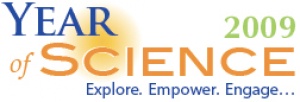CyArk Joins COPUS Year of Science: 2009
Celebrate A Year of Science: 2009 with Science Education Resources Available on CyArk
March 3, 2009
2009 has been declared as the "Year of Science" in the US, a national year-long celebration to engage the public in science and improve public understanding about how science works, why it matters, and who scientists are. The designation was conceived by COPUS (Coalition on the Public Understanding of Science) and has sparked many events and projects in all 50 states.
CyArk is proud to be a member of COPUS and excited to be part of this national movement encouraging the exploration of science. Throughout the Year of Science, the CyArk Education blog will feature science themed posts and highlight articles correlated with the monthly science themes from COPUS. CyArk will also be developing new lesson plans, experiments, and activities using CyArk resources for hands-on science investigations. Be sure to check for these new activties on the CyArk Education blog!
Currently on the CyArk website there are a variety of ways to explore science, ranging from lesson plans with guided experiments for children to tools that allow researchers and the public to explore and manipulate laser scan point clouds and scientific data.
CyArk has developed online, interactive tools for the general public and those interested in exploring their world. The CyArk 3-D Point Cloud Viewer is a unique tool developed by CyArk. The 3-D Point Cloud Viewer enables users to manipulate 3-D point-cloud models, take dimensions, create architectural drawings and investigate a subject from any viewpoint. The 3-D Viewer can be used for a number of educational purposes and scientific inquiries. Use the CyArk 3-D viewer to measure the height of each of the steps of the El Castillo and investigate how much paint the Maya would have need to paint the pyramid. Measure the windows of Tambo Colorado to examine the precision of Inka engineers or measure Tudor Place's Neoclassical facade to determine the symmetry.
The Hazard Map was developed by CyArk to promote the understanding of the hazards faced by heritage sites and modern cities. To help visualize and understand the impact of seismic activity and potential sea level rises, the CyArk Hazard Map displays inundation levels and plots previously recorded earthquakes to demonstrate the vulnerability of cities and heritage sites. The Hazard Map is fully interactive and users can investigate specific cities or heritage sites and manipulate a number of variables to visualize seismic threats and the impact of global warming to heritage sites.
The CyArk Education website has many tools and resources that can be used by educators and parents to engage kids in the scientific process. A number of the branches of science are represented in the CyArk online lesson plans-including archaeology, physical science, geology and environmental science. These lesson plans also place a heavy emphasis on scientific inquiry and hands-on science experiments. In the "Archaeology and Erosion" lesson plan, students use sugar cube models to observe the effects of erosion on archaeological sites. In the activity, students design an experiment for testing out each of the factors of erosion and determine which factor has the greatest impact on their sugar cube model of a Mayan temple.
In the "Global Warming: The Effect of Rising Sea Levels" activity, students investigate global warming and the effect rising sea levels on cities and archaeological sites. Students conduct an experiment using common household items to observe the impact of melting ice on seas levels. Students also use the interactive CyArk Hazard Map tool to investigate effect on rising sea levels on cities and heritage sites around the world.
Be sure to check the CyArk Education blog periodically for new lesson plans and activities as we celebrate a Year of Science!

